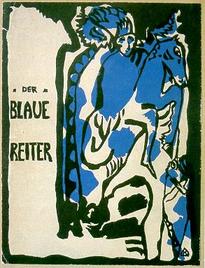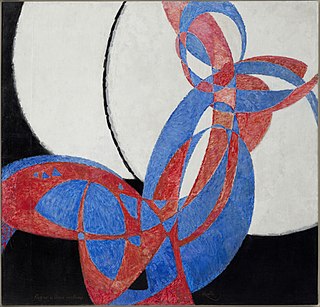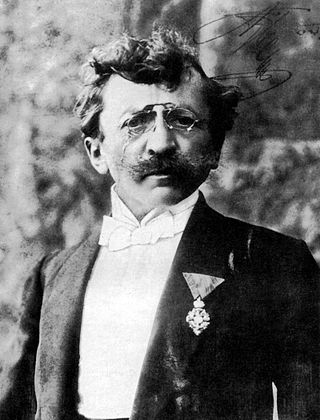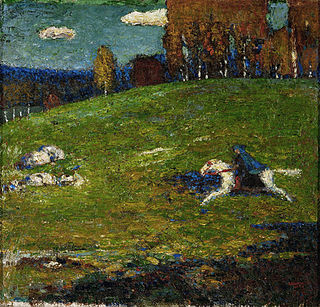
Wassily Wassilyevich Kandinsky was a Russian painter and art theorist. Kandinsky is generally credited as one of the pioneers of abstraction in western art. Born in Moscow, he spent his childhood in Odessa, where he graduated from Odessa Art School. He enrolled at the University of Moscow, studying law and economics. Successful in his profession, he was offered a professorship at the University of Dorpat. Kandinsky began painting studies at the age of 30.

Abstract art uses visual language of shape, form, color and line to create a composition which may exist with a degree of independence from visual references in the world.

Robert Delaunay was a French artist of the School of Paris movement; who, with his wife Sonia Delaunay and others, co-founded the Orphism art movement, noted for its use of strong colours and geometric shapes. His later works were more abstract. His key influence related to bold use of colour and a clear love of experimentation with both depth and tone.

Der Blaue Reiter was a group of artists and a designation by Wassily Kandinsky and Franz Marc for their exhibition and publication activities, in which both artists acted as sole editors in the almanac of the same name. The editorial team organized two exhibitions in Munich in 1911 and 1912 to demonstrate their art-theoretical ideas based on the works of art exhibited. Traveling exhibitions in German and other European cities followed. The Blue Rider disbanded at the start of World War I in 1914.

Geometric abstraction is a form of abstract art based on the use of geometric forms sometimes, though not always, placed in non-illusionistic space and combined into non-objective (non-representational) compositions. Although the genre was popularized by avant-garde artists in the early twentieth century, similar motifs have been used in art since ancient times.

Gabriele Münter was a German expressionist painter who was at the forefront of the Munich avant-garde in the early 20th century. She studied and lived with the painter Wassily Kandinsky and was a founding member of the expressionist group Der Blaue Reiter.

The Neue Künstlervereinigung München (N.K.V.M.), was an Expressionism art group based in Munich. The registered association was formed in 1909 and prefigured Der Blaue Reiter, the first modernist secession which is regarded as a forerunner and pathfinder for Modern art in 20th-century Germany.

Anton Ažbe was a Slovene realist painter and teacher of painting. Ažbe, crippled since birth and orphaned at the age of eight, learned painting as an apprentice to Janez Wolf and at the Academies in Vienna and Munich. At the age of 30, Ažbe founded his own school of painting in Munich that became a popular attraction for Eastern European students. Ažbe trained the "big four" Slovenian impressionists, a whole generation of Russian painters, Serbian painters Nadežda Petrović, Beta Vukanović, Ljubomir Ivanović, Borivoje Stevanović, Kosta Miličević, and Milan Milovanović or a Czech painter Ludvik Kuba.

20th-century Western painting begins with the heritage of late-19th-century painters Vincent van Gogh, Paul Cézanne, Paul Gauguin, Georges Seurat, Henri de Toulouse-Lautrec, and others who were essential for the development of modern art. At the beginning of the 20th century, Henri Matisse and several other young artists including the pre-cubist Georges Braque, André Derain, Raoul Dufy and Maurice de Vlaminck, revolutionized the Paris art world with "wild", multi-colored, expressive landscapes and figure paintings that the critics called Fauvism. Matisse's second version of The Dance signified a key point in his career and in the development of modern painting. It reflected Matisse's incipient fascination with primitive art: the intense warm color of the figures against the cool blue-green background and the rhythmical succession of the dancing nudes convey the feelings of emotional liberation and hedonism.
Otto Nebel was a German painter born in Berlin, Germany.

Composition VII is an abstract oil painting executed in 1913 by Wassily Kandinsky, a Russian-born painter. It is in the collection of the Tretyakov Gallery, in Moscow. Art historians have concluded that the work is a combination of the themes of Resurrection, Judgment Day, the Flood and the Garden of Eden.

Caoutchouc is a painting created circa 1909 by the French artist Francis Picabia. At the crossroads of Cubism and Fauvism, Caoutchouc is considered one of the first abstract works in Western painting. The painting is in the collection of Centre Pompidou, Musée National d'Art Moderne, in Paris.

Modern Theosophy has had considerable influence on the work of visual artists, particularly painters. Artists such as Wassily Kandinsky, Piet Mondrian, and Luigi Russolo chose Theosophy as the main ideological and philosophical basis of their work.

The Blue Rider is an oil painting executed in Bavaria in 1903 by the Russian emigré artist Wassily Kandinsky. It is now held in a private collection in Zürich, and shares its name with an almanac and the art movement he would co-found with Franz Marc in the early 1910s.

Composition X is an abstract oil painting created in 1939 by the Russian émigré artist Wassily Kandinsky, then living near Paris. It is part of the collection of the Kunstsammlung Nordrhein-Westfalen in Düsseldorf, Germany.

Landscape with Red Spots was the name given to each of two successive oil paintings produced in Bavaria in 1913 by the Russian émigré painter Wassily Kandinsky. The first is now in the Museum Folkwang, in Essen, Germany. The second, known as Landscape with Red Spots, No 2, is in the Peggy Guggenheim Collection, in Venice.

Erster Deutscher Herbstsalon was the title of an art exhibition that was organized in 1913 by Herwarth Walden in Berlin.

Auf Weiss II (Sur blanc II), in English: On White II, is a 1923 oil-on-canvas painting by Russian painter Wassily Kandinsky. It was created when the artist was a teacher at the Bauhaus in Weimar. The painting initially hung in the dining room of Wassily and Nina Kandinsky's apartment at Bauhaus Dessau. Since 1976, as a gift from Nina Kandinsky, it has been in the collection of the Musée National d'Art Moderne, in Paris.

Portuguese Woman, also known as Tall Portuguese Woman, is an oil and wax on canvas painting by the French painter Robert Delaunay, created in 1916. It is held in the Thyssen-Bornemisza Museum, in Madrid. There are others similary named paintings by the same artist from this phase, in other museums.


















